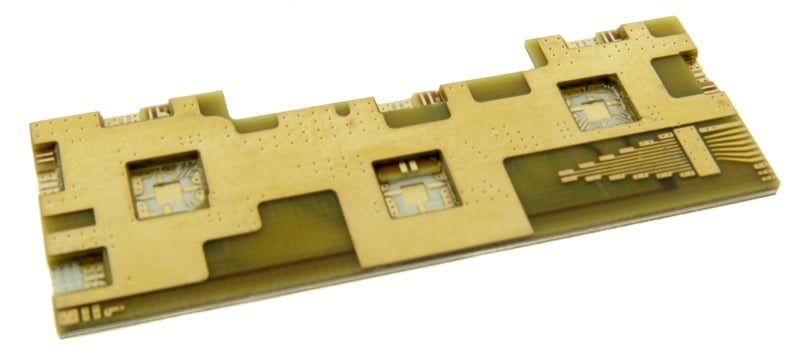When talking about the world of technology, we often focus on the performance that circuitry and components provide to keep up with the fast-paced electronics we use in commercial businesses and our daily lives. We are achieving higher processor speeds and frequencies that become demanding on present printed circuit boards (PCBs). Yet, we also need to focus on the sizes of the applications that can have an impact on the PCB design.
Devices are getting smaller, lightweight, and portable. From slim phones to wearables (such as smart watches) these products require microelectronic manufacturing capabilities combined with the standard surface mounted technology (SMT) to create PCBs that can handle the higher performance demands reliably without succumbing to operational limitations that may appear due to the PCBs smaller sizes. The merging of SMT and microelectronic manufacturing is also called hybrid PCB manufacturing.
What is a Hybrid PCB?
A hybrid PCB involves using dissimilar materials instead of one material throughout to create the substrate core layers as well as the dielectric layers. The purpose of using dissimilar materials is to try to bring all the positives into the PCB manufacturing process (such as greater signal performance, a more stable dielectric constant, and good electrical strength) while also cutting down on the negatives that one type of material may have (such as poor heat transfer capabilities) by having a dissimilar material that has better coefficient of thermal expansion (CTE) rates.

Example of a complex RF hybrid PCB designed with cavities.
What Types of Materials Can Be Used in Hybrid PCBs?
When talking about dissimilar materials, there may be two completely different laminates, such as FR-4 and PTFE, placed into the same PCB. The layers could also consist of different laminates in the same material family, such as ceramic-filled PTFE laminated 3000 series offered by the Rogers Corporation, as the manufacturer will make minor changes to the material's formula to create various dielectric constant rates and dissipation factors so the materials can be used in specific applications.
The types of dissimilar materials that will be used for your hybrid PCBs will be based on what the application will do, its power needs, environmental factors, and other design aspects. Common types of materials that are used include:
FR-4
Flame Retardant 4 (FR-4) is reinforced glass epoxy that is standard throughout the PCB industry. It is highly desired due to its low costs, high dielectric strength, and great electrical insulation as it is also temperature resistant and moisture resistant, so it can be used in a wide range of applications. However, there are a few setbacks that make them unsuitable for high digital circuits or for the newer higher frequencies that are being developed (fifth generation or 5G wireless communication). It experiences high dielectric loss for microwave frequencies.
PTFE
Polytetrafluoroethylene (PTFE), also referred to as Teflon, are woven fiberglass/ceramic filled plastics that are acceptable replacements for FR-4 laminates when developing high speed PCBs. Their dielectric constant ratios are anywhere from 3.5 or lower, making them ideal for high frequency applications when requiring low signal loss and better impedance control. PTFE is also used for applications that will experience higher temperatures as it provides good mechanical stability. A downside with PTFE is that it costs more than FR-4, and although it has temperature stability, it will experience dielectric loss at higher temperatures and will have dimensional changes due to being a softer material.
Polyimide
We often talk about polyimide when it is used for rigid-flex and flexible PCBs. Yet this flexible polymer film also works well for hybrid, multilayer PCB applications. The material offers a high level of chemical resistance, works well with a wide range of temperatures, and has good electrical properties. Polyimide laminates are flexible and lightweight, making them suitable for portable applications. One of the major disadvantages of polyimide laminates are the costs, as they are more expensive than FR-4 and PTFE.
Why Use Different Materials for Hybrid Designs?
The main reason for using different materials to create multilayer PCBs is to limit poorer mechanical and structural properties found in some laminates by combining them with the superior characteristics offered by others. For example, PTFE has excellent electrical characteristics yet can experience structural integrity issues at certain temperatures. To offset this disadvantage, a fabricator can combine polyimide into the layers because of its better mechanical properties.
Another reason to use a combination of materials is to cut down on costs while still gaining the necessary high performance when it is necessary. FR-4 and PTFE will often be combined with hybrid designs. The low costs of advantages allow for the FR-4 to provide adequate benefits for low-speed applications, while the PTFE will be used for more critical PCB functions. In addition, FR-4 may be used to even out thickness issues for the laminate layers. It can be added in certain places to act as the glue to hold everything together and to provide an more even printed circuit board.
Issues to Know About When Designing Hybrid PCBs
While trying to provide multilayer PCBs that provide all the advantages while lowering the potential costs, there are several important factors that must be considered during the design phase when selecting materials. Each laminate (FR-4, FTPE, and polyimide) has differing values for their CTE. This value signifies the amount of dimensional changes that the laminate will experience with varying temperatures. When the heat along the PCB is increased, the material can expand if it has a high CTE ratio. Too much expansion can cause the PCB laminates to warp, decompose faster, or separate.
For multilayered hybrid PCBs, layer separation is a major issue that must be addressed. Since the fabricator will be using different materials with varying CTE rates, one material may expand during the temperature change while the other material will shrink or will have little changes. So, the layers become separated. Delamination can also occur for the copper interfaces on the substrate. The laminate layers start to peel away. Understanding the time of delamination for materials is essential to deal with major temperature fluctuations within the application so that these issues can be resolved.
Another significant issue when designing hybrid PCBs involves the stack-up process. Having the right thickness for the PCB for each panel and piece is necessary to meet the specified overall thickness requirement without hampering the required frequencies. Yet the adhesive system that will be used for hybrid PCBs can vary based on which materials will be used. Providing the right amount of insulation can ensure that the PCB will have the right thickness, as often a no-flow FR-4 prepeg will be used. However, the added materials may make the PCB too thick for the actual application.
Lastly, not every company has the knowledge or experience to create hybrid PCBs. PCB fabricators will have varying processes and may work with specific materials or circuit board applications such as rigid flex or flexible PCBs. In addition, the fabricator will need to be aware of specific issues that occur with etching multilayer PCBs, such as material contraction (shrinkage) when the copper is etched off, that can impact the laminate construction process.
Speaking with the fabricator at the early phases of the design concept will allow them to understand your application's needs as they can suggest the types of materials that can be used. In addition, you can learn more about the fabricator's capabilities and machine processes to learn whether they would be a good fit for your PCB project.
When Should You Use Hybrid PCB Builds?
Deciding on the right time to have a hybrid PCB build will mainly depend on the application's functions, the temperatures that will be present, the types of frequencies for the PCB, and the costs. One of the great aspects of hybrid builds is that it allows you to expand your creativity when it comes to developing the PCB that will have all the electrical and mechanical properties that are desired, which can provide more customized and tailored PCBs that are a better fit for the application.
Also, cost considerations will play an important factor with hybrid designs. Seeking a lower cost for the PCBs may be wanted yet could result in a lower quality circuit board that doesn't fulfill its desired functions. This problem is what will normally occur when only working with one type of PCB laminate. Instead, you can gain the cost advantages of having a cheaper material used in places that don't require higher functions or frequencies and add smaller quantities of the higher-cost materials for greater mechanical, electrical and thermal properties in specific sections of the PCB.
Summary
Here at Epec, we work with customers to design the right PCBs for their applications, whether they are in need of low to medium frequency rigid boards or high frequency flex or rigid flex PCBs. We also are knowledgeable about hybrid manufacturing challenges that are faced when developing odd shaped PCB outlines, providing consistency for the plated through holes so as not to damage the hole wall quality for different materials, and will use the right processes for controlled depth routing patterns. Reach out to our team if you have any questions about whether a hybrid PCB design may be appropriate for your applications.
Key Takeaways
- Hybrid PCBs combine multiple laminates: Using dissimilar materials such as FR-4, PTFE, or polyimide within one build allows engineers to balance electrical, thermal, and mechanical performance while controlling costs.
- Material choice drives functionality: PTFE offers low-loss, high-frequency performance, FR-4 provides cost-effectiveness and structural support, and polyimide contributes flexibility and chemical resistance. Selecting the right mix depends on the application’s speed, temperature, and environmental demands.
- Cost and performance trade-offs: Hybrid builds allow expensive, high-performance materials to be used only where necessary, while lower-cost materials fill in less critical areas, achieving both reliability and affordability.
- Design challenges are significant: Mismatched coefficients of thermal expansion (CTE) between laminates can cause delamination, warpage, or copper separation under temperature shifts. Adhesive systems and stack-up thickness also require careful planning.
- Early collaboration with your fabricator is essential: Not every PCB supplier has the capability to process hybrid builds. Engaging experienced fabricators early helps address stack-up, etching, and lamination challenges while ensuring the design is manufacturable.
















